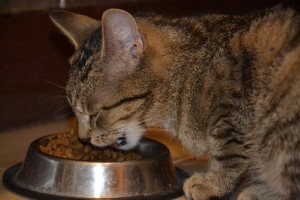If your cat is a bit on the fussy side, ill, or elderly, resulting in a food change, you may encounter his finicky side and recognize how much your cat dislikes change. Helping Fluffy to like a new food or transition to a special diet can be quite the challenge. Here are some tips that just may encourage her to eat.
Diet Change. There are many reasons why you may need to change your cat’s diet. Perhaps Fluffy has kidney problems, food allergies, or is a bit overweight and your vet recommends a special food. Needless to say, the process can be somewhat traumatic for all involved. For the most part, Fluffy would be happy eating the same old thing every day and a change to her routine may result in one stubborn cat.
Gradual Changes. Unless your vet suggests otherwise, it’s best to make any diet changes gradually, preferably over a one week time span. You see, Fluffy has bacteria and enzymes that have already adjusted to digesting her old food, so any sudden diet change can cause digestive issues such as stomach pangs, diarrhea and vomiting. A good rule of thumb when changing your pet’s food is to follow a 3:1 ratio during the first three days (75% old food mixed with 25% new food), a 2:1 ratio for days 4 – 5, and a 3:1 ratio during the last few days (only this time, 75% new food mixed with 25% old food).
Changing from Dry Food to Wet Food. Many vets these days are recommending wet food for cats over dry food. While both types of food can be nutritionally sound, wet food naturally has a greater moisture content, which is beneficial to cats with urinary issues or diabetes. For cats who are accustom to dry food, making the transition can result in a kitty hunger strike. For starters, try adding some warm water to her dry food, letting it sit for five minutes to soften before feeding her. This will give Fluffy the opportunity to get accustom to a new texture, but with the same taste. Then follow the same ratios and timeframe as above, mixing Fluffy’s dry food with the new wet food. If refusal to eat the wet food still persists, try grinding up some of the dry food into a powder and sprinkle it atop the wet food.
A Little Coaxing May Be in Order. Still having trouble getting Fluffy to eat her new food? Many cats will eat if they are patted or hand-fed. Either technique may be enough to get her started, so try giving her a nice long, slow stroke from head to tail as she investigates her food. The soothing motion could influence her to eat. If not, try petting her while you offer her food from your hand.
Encourage Playtime. A physical cat is a hungry cat, so get out the laser pointer or wind-up mouse and encourage Fluffy to frolic.
What to Do if Nothing Seems to Work. While some cats seem to make a smooth transition when their food is changed, others can be much more finicky and stubborn. The gradual approach will eventually work for even the most reluctant cat, but if all else fails, consult your vet as a lengthy hunger strike on your cat’s part can result in serious illness.






